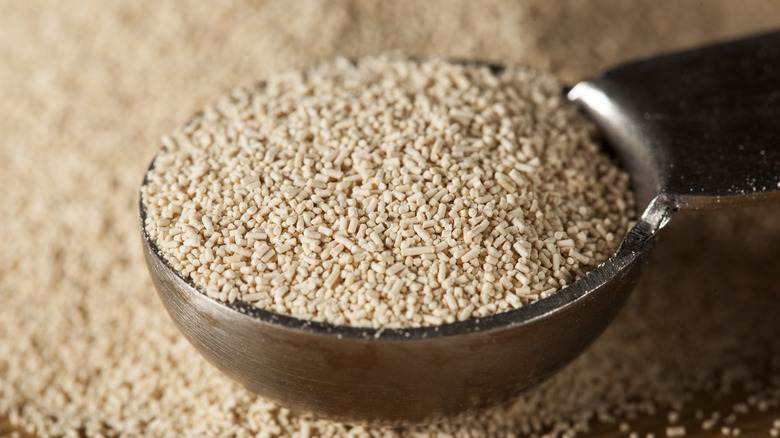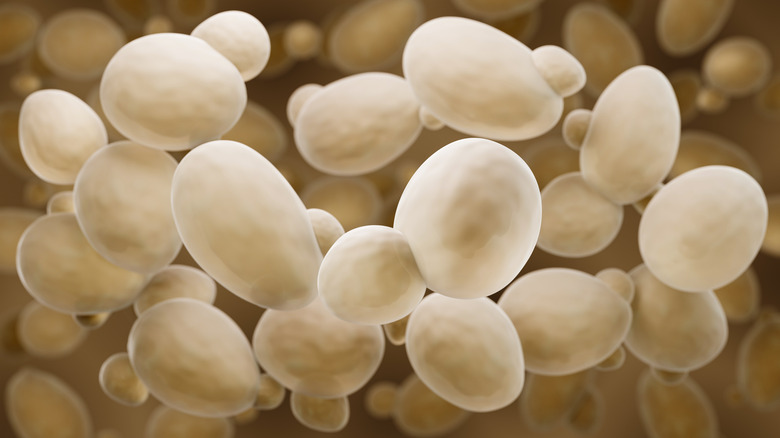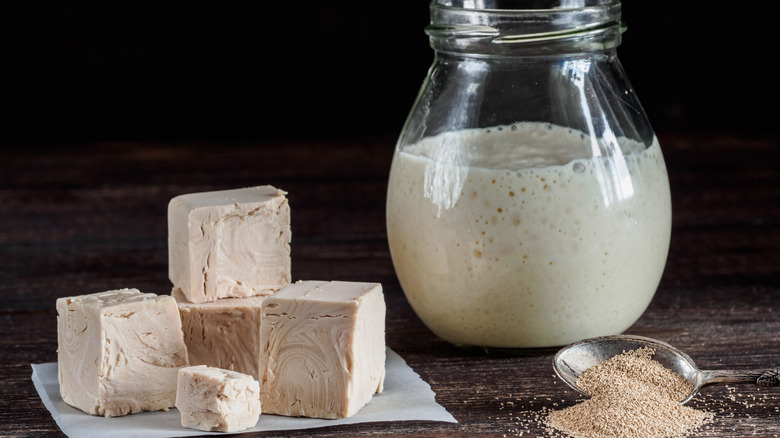Here's What It Means To 'Activate Yeast' In Baking
Bread recipes that use yeast will typically include a step that involves activating the yeast, which involves putting it in warm water and letting it sit for a while. Did you ever wonder what, exactly, is going on there? There's actually a fascinating bit of science going on in your kitchen, and if you're also wondering if there's a way to optimize that activation, you're going to love what we're going to talk about.
Yeast is made up of about a bajillion (we counted) tiny organisms, and those little granules that we call yeast are actually clumps of these microscopic creatures. There are more than 1,000 different types of yeast — although there are only a few that are using in food production like baker's, brewer's, and distiller's yeasts — and they're all a type of fungus. The packets of yeast you have in your cupboard just waiting to be used in your favorite crusty bread recipe likely contain dry yeast, and that's important.
You can think of dry yeast as being dormant. Yeast cells, just like any other living creature, need sustenance. While they're dry, they have nothing to feed on. Once they're exposed to a food source, that's when the really interesting things start to happen.
Activating yeast means to feed it and bring it back to life
Remember Sea Monkeys? Those were the little packets of a dusty-looking powder that sold in dry packets, which would then seem to magically come to life. Yeast is kind of like that — and interestingly, yeast is one of the main food sources for those sea monkeys, which are actually brine shrimp. Neat, right?
The idea is the same: Yeast cells are inactive when they're dried, and when you take that step in the recipe that calls for adding yeast to sugar and warm water, you're essentially giving the little creatures food. The sugar acts as nutrients, kick-starting the life cycle of the yeast. They start to feed, and they also start to produce carbon dioxide as a waste product.
That release of carbon dioxide causes the bubbles that you'll start to see form, and that's what makes bread rise. It's also what causes the pockets of air to form in the bread. Activating the yeast by bringing it back to life and starting the cycle of turning food into carbon dioxide means that when you mix that living, breathing, gas-producing yeast into your dough, it's already going to be releasing gas. Dough will rise better, bread will be lighter and more airy, and you're more likely to get a final product that will make any commercial baker proud.
Temperature makes a big difference in activating yeast
Yeast, it turns out, is pretty particular about the conditions that it will react best to, and that means when you're activating it for, say, your favorite sesame Sicilian bread recipe, you're going to want to check the temperature of the water first — along with the type of yeast you're using.
Some yeast will be labeled as Active Dry Yeast, and in that case, you're going to want to use water that's between 100 and 110 degrees Fahrenheit. Other types of yeast — like RapidRise and Bread Machine yeast — prefer things a little hotter, and will do best when exposed to water that's between 120 and 130 degrees Fahrenheit. In some cases, live (or fresh) yeast might call for temperatures of only around 95 degrees Fahrenheit, so reading the package is crucial. This activation — which is also called "blooming" — usually takes about ten minutes. By then, the yeast will have started to consume the sugars that activation always calls for, and you should start to see some foam.
If not, it's possible your yeast is dead. That can happen if you've left it past the "Use By" date, or it can mean your water was too hot. Some types of yeast will start to die at 120 degrees Fahrenheit, which illustrates exactly why it's incredibly important to use the right temperature for the right yeast. By 140 degrees Fahrenheit, most yeast is pretty much mostly dead... and that will doom your baking project from the very first steps.


